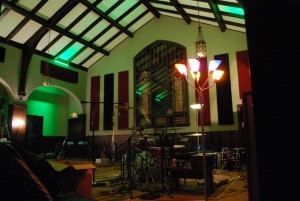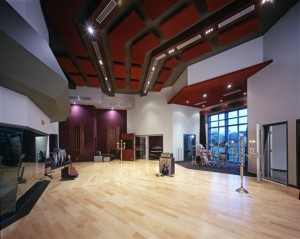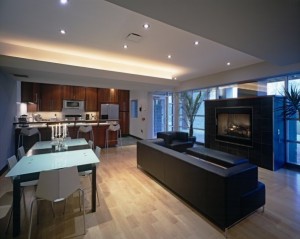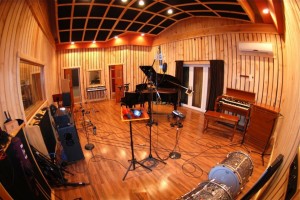Recording Studio Retreats – Spring 2013
Bustling cities like New York, L.A., San Francisco and Nashville may boast more recording studios per square foot than just about anywhere else on earth. With such high concentrations of talented professionals, it’s not surprising that so many commercial records are made, at least in part, inside of one of these major markets.
Then there’s a second tier of studio towns – places like Chicago, Miami, Seattle, DC, Atlanta, Philadelphia, Portland, Boston and Austin – where recording culture is alive and kicking, although perhaps not quite as densely packed or competitive as it is in the big four.
But major cities aren’t the only place to make records. Artists from Led Zeppelin and U2 to Bon Iver and Beach House have long escaped into the countryside to complete their crowning works. With that in mind this week, we’ll look at three “recording retreats” – studios with onsite living accommodations, that bring the luxuries of a metropolitan tracking room into quieter, more affordable, more scenic locales.
Echo Mountain Recording
Asheville, North Carolina
There’s a recording studio in the small city of Asheville, North Carolina, that sits nestled into the Blue Ridge Mountains, not far from where the French Broad River meets the Swannanoa.
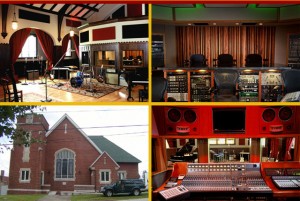
Views of Echo Mountain. Photo courtesy of Glazer Architecture.
This region, nicknamed “Land of the Sky,” has developed something of a hybrid culture over the years. The population is fairly small and spread-out, but the area is home to a startling number of transplants from the coastal cities.
These ex-pats from New York, California, Washington, and bustling cities all around the U.S. are often credited with giving the place its dynamism. But by and large, they come to the town to adapt, not to overturn, and so it’s become one of those rare places where cosmopolitan tastes meet homespun values. The whole city sits at the center of a culture that revolves in part around craftsmanship and art.
“I think the city of Asheville itself is such a big part of why people come here to record,” says Echo Mountain‘s chief engineer Julian Dreyer. “People will be playing a show in town, and come for a studio tour and they’ll say ‘Wow, there’s this great studio here, and the town is incredible. I just want to spend two weeks here and make a record.’”
“There’s a huge appreciation here for arts and crafts, and all these little communities of artists and musicians,” Dreyer says. “That attitude leads to stuff like great food and restaurants. The bar for that is set so high now that unless you’re on top of your game you just won’t survive. So it’s a city of not even 100,000 people, but we’ve got food here that would rival your most ‘hipster’ parts of Brooklyn.”
“And there’s probably more little breweries here per capita than almost anywhere,” he says. They’ve even been voted “Beer City USA” three years in a row, just narrowly beating out Portland, Oregon. “People here are so proud of Asheville that they get so pumped up to vote in that kind of thing.” And it shows: Dreyer has a slow-spoken manner and just the shadow of a Carolina drawl, but he livens up when he talks about Asheville even more than when he talks about microphones.
Of course there’s more to Echo Mountain Recording than just the town. It’s more than just a studio – almost a little musician’s complex in its own right, sporting 4 full-fledge production rooms, the largest of which – built into an deconsecrated old church – houses a drool-inducing Neve 8068 console, a Studer A800 reel-to-reel and a full-blown Pro Tools HD3 system.
This main space, as well as Echo Mountain’s newer API-based studio in the adjoining building, was designed by the legendary George Augspurger. Two smaller studios round out the space, offering even more affordable rooms for overdubs and the like. None of them are hurting for instruments or mics either, and vintage Telefunkens, AKGs and Neumanns float from room to room.
Records made at Echo Mountain earned three GRAMMY nominations and two wins this year; but don’t let names like Smashing Pumpkins, Steve Martin, T. Bone Burnett, War on Drugs, G Love, VHS or Beta, The Avett Brothers, Zac Brown or Band of Horses scare you away. They also spend a fair chunk of time recording new acts from out of town, as well as local and regional artists.
Saint Claire Recording Company
Lexington, Kentucky
“Our motto for the longest time has been ‘Relax, Record,’” says John Parks, co-owner of Saint Claire. “We want to get you out of the city and – hopefully – to turn off your cellphone and close your laptop.”
“Often, relaxation is the last thing that people think about when they’re recording,” Parks says, “but it’s actually a pretty important thing, I think. Is that 15th hour as productive as that 3rd hour in the middle of the day?”
This concept factored into most of the decisions that the Parks made when they built Saint Claire Recording Company, a 7,800-square-foot facility just five minutes outside of downtown Lexington, Kentucky.
For anyone who hasn’t been, these parts of Kentucky can be astonishingly picturesque, especially around sunset, as dusk gathers around the rolling hills. It’s long been the style in Kentucky to cut back the trees and nurture the local bluegrass for grazing, so that when you do catch a large black oak standing on the horizon, it’s silhouetted against the sky like an old watchman looking over the homestead.
“We thought that instead of building just another studio in Nashville, we could try and tap into that slower pace of life, and maybe help put Kentucky, and Lexington in particular, on the studio map.”
If the Parks’ goal was to take the accoutrements of a world-class SSL 9000J studio and put it into the context of small-town living, they have succeeded. But as quaint as Lexington might seem to a New Yorker, it’s certainly not the boondocks. It may only be the 62nd largest city in the U.S., but it’s the 10th most educated, with nearly 40% of residents in the city proper having earned college degrees.
It has its own attractions too: the bourbon trail, historic museums, and horse racing – particularly the Kentucky Derby – which takes place not far away in Louisville, KY, a place Parks describes as “like a metropolis” compared to the small-but-growing city of Lexington.
Saint Claire has become something of a destination for some busy coastal engineers including the legendary Tony Visconti, Neil Dorfsman, and our own Zach McNees. The clients they bring with them come from fields as far flung as Japan, Spain, Ireland and Canada, and to accommodate them all, Saint Claire has five bedrooms right on premises.
“When the client is here, we want them to treat it like it’s their house,” Parks says, “and when you shut the door behind you at the end of the day, you wouldn’t even know there’s a studio footsteps away.”
Since it attracts so many traveling producer/engineers, the studio’s house engineer, Tim Price, often finds himself putting on his assistant hat. It’s a role he’s equally comfortable with, having risen up from the ranks of intern at Saint Claire.
And although the recording space is well-separated from the living quarters, the studio itself was designed with special attention placed on sight-lines:
“When we were designing it I wanted to squeeze in as many separate isolation booths as we could,” Parks says. “We ended up with four. And with the way the windows are placed it’s the closest you ever might come to the feeling of playing live in one room, while still being able to turn up the amps nice and loud.”
But as much as it’s equipped for a full-on rock session, Parks says they attract more singer/songwriters. They’re often the ones, he says, that best understand the value of getting unplugged and closing the door.
Black Dog Recording Studio
Stillwater, New York
Luckily, New Yorkers don’t have to go far to get away from it all. Black Dog Recording Studio sits just outside of Albany, tucked into the foothills of the Adirondack Mountains, in the small town of Stillwater, about three hour’s drive up the Hudson River from Manhattan.
Black Dog sports a 600-square-foot live room, a 400-square-foot control room, and three isolation booths. There’s a three-bedroom, two-bathroom house available on the property, and the gearlist offers a tempting melange of top-shelf condenser and ribbon microphones, a unique mid-70s Sphere console, and some early American tube preamps from Collins, Gates and RCA, in addition to the more standard fare from API and Quad Eight.
They may be the youngest studio on this list, so their amenities keep growing. For the spring, studio manager Seamus McNulty says they plan to add a 2” Studer machine and some rustic cabins for extra lodging.
McNulty describes the Rod Gervais-designed live room at Black Dog as “bright and tight” – and ideal for recording a whole band live together on the floor if they choose. For those who want even more control, the three iso booths are ample, with the smallest of them capable of fitting a harpist. The space is rounded out with a small library of guitars, amps and keyboards, including an original B3, and a complete line of vintage Ampegs.
Despite its size, gear and proximity to the big city, Black Dog is a shockingly affordable room (one of the perks of setting up shop in a small town.) The space has attracted its share of notable upstate acts like Ra Ra Riot, Sean Rowe and Railbird, and now, a growing number of New York City producer/engineers like Joe Blaney, Jonathan Jetter, and Andrew Maury, who gives the space rave reviews.
Justin Colletti is a Brooklyn-based audio engineer, college professor, and journalist. He records and mixes all over NYC, masters at JLM, teaches at CUNY, is a regular contributor to SonicScoop, and edits the music blog Trust Me, I’m A Scientist.







